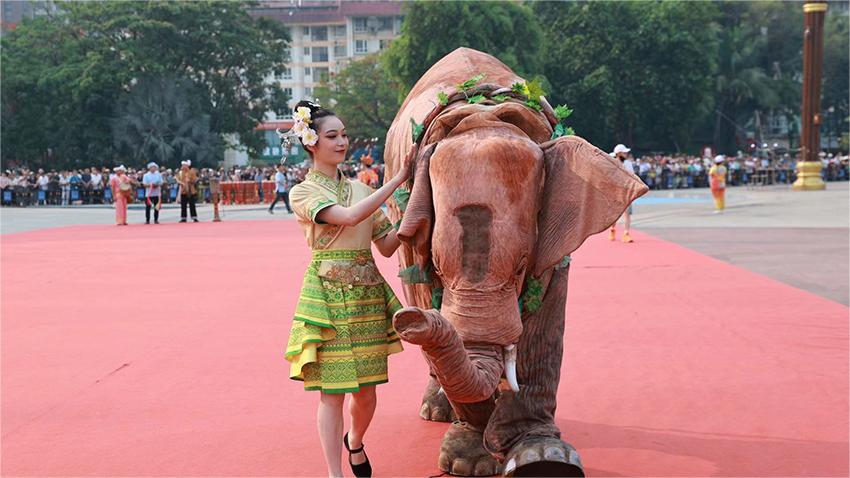Ancient slips mirror the rise and fall of Qin Dynasty
CHANGSHA, April 18 (Xinhua) -- Recent research by Chinese archaeologists has found that women in the Qin Dynasty (221 B.C. - 207 B.C.) possessed property inheritance rights and may have shouldered similar social responsibilities as men.
The latest discoveries from the Liye Qin Slips dating back to the Qin Dynasty are expected to shed light on certain aspects of this rarely documented historical period, as exemplified by numerous vivid and detailed accounts.
A slip unearthed from the Liye ancient town site reveals that a father named Guang registered at the local government office to distribute his property to his daughter Hu, who was preparing for marriage.
The property included people, goods and money totaling eleven kinds. This slip was certified by a local government official named Shen at the time.
"The sum of money were equivalent to the income of a full-time working adult male for twenty years at that time," said Zhang Chunlong, a researcher at the Hunan Provincial Institute of Cultural Relics and Archaeology and one of the excavators of the Liye Qin Slips.
The slips also record instances of widows managing households independently and women participating in various labor activities alongside men, indicating that men and women enjoyed equal social responsibilities in the Qin Dynasty.
The Liye ancient town is located in Longshan County in Xiangxi Tujia and Miao Autonomous Prefecture in central China's Hunan Province. In 2002, over 36,000 slips from the Qin Dynasty were unearthed from the No. 1 well of the site, with the total word count exceeding 200,000.
Considered another important finding in Qin Dynasty archaeology following the Terracotta Warriors, these slips mainly consist of government documents from the Qianling County in Dongting Prefecture, spanning from the year before the nation's unification to the year before the fall of the Qin Dynasty.
The contents cover demographics, production, taxation, postal services, judiciary and medicine, among others, providing a complete picture of the governance of Qin Shi Huang, China's first emperor, and the functioning of grassroots administrative systems.
"Information about the Qin Dynasty has always been limited, and these vast textual materials, once interpreted and organized, can fill in historical gaps," said Long Jingsha, an archaeologist and leader of the excavation at No. 1 well of Liye ancient town.
The Liye Qin Slips indicate the smooth transmission of various official documents in the Qin Dynasty, efficient requisition of materials, and detailed records of personnel management systems, demonstrating the establishment of a top-down supervision and assessment system during the reign of Qin Shi Huang, according to Long.
The Qin Dynasty implemented the administrative system of prefectures and counties, fostering close ties between the central and local governments. The system was not only innovative but also a significant contribution to Chinese history, followed by later dynasties, according to Zhou Dongzheng, curator of the Liye Qin Slips Museum.
The specific number and names of prefectures established during the Qin Dynasty have been subject to various interpretations, but the mention of Dongting Prefecture in the slips, not found in any extant historical documents, provides a new opportunity to reconsider the administrative divisions of the Qin Dynasty.
Historical records show that the Qin Dynasty promoted the standardization of writing, unifying the names of many things according to Qin customs and systems.
In an era when communication and transportation were underdeveloped, central government decrees could directly reach remote border areas like Qianling County, indicating the high degree of centralization of power under the Qin Dynasty, with a well-established postal system, according to the experts.
"The speed of upward and downward transmission of official documents reflects the efficiency of the state machinery," Zhang said. During the Qin Dynasty, government offices generally operated from around six or seven in the morning to four or five in the afternoon, with document transmission occurring throughout the day.
At various levels of government, smooth communication channels were maintained through relay couriers. The sending, receiving and delays of official documents were meticulously recorded on the slips, with timestamps accurate down to two-hour intervals.
The government documents on the Liye Qin Slips also include records assessing the performance of local officials. For example, county governors and prefects during the Qin Dynasty were required to report annually to the imperial court on the governance of their jurisdictions, based on which the court issued rewards and punishments," Zhou said
It can be seen that the Qin Dynasty implemented a strict system of official assessment, linking official performance with salary and promotion, among others, thus encouraging officials to improve their efficiency.
Records on various aspects such as official attendance, designations and transfers can be found. These include "resumes" detailing officials' positions and date of appointments and "attendance records" showing how many days each official attended and how much work they completed.
The Liye Qin Slips also documents numerous individuals prosecuted under the stringent laws of the time. For instance, a set of twelve remarkably well-preserved slips detail twelve men from Yangling County being pursued for debts owed to the government. Due to their inability to repay, they were forced into labor as compensation.
"According to the standard daily wage at that time, each person would have to serve three years and eleven months, indicating the severity of Qin Dynasty law," Zhang said. The slips detail the number of people in forced labor and their situations regarding escape and death.
In the twelfth lunar month of the 34th year of Qin Shi Huang's reign (213 B.C.), Qianling County alone had 4,376 people sentenced to lifelong labor. Within a year, one out of every seven individuals sentenced to forced labor died.
So far, more than half of the Liye Qin Slips data has been made public. "The unification and governance of the Qin Dynasty posed significant challenges, and while each meticulously written slip may have contained mundane administrative content at the time, they are now regarded as marvels," Zhang said.
Photos
Related Stories
- China's archaeological site parks register strong revenue growth
- China unveils highest-level Chu state tomb excavated to date
- Ancient noble tomb found in east China's Jiangsu
- Scientists restore profile of ancient Chinese emperor through genetic analysis
- Belt and Road archaeological cooperation fosters closer friendship among civilizations
- Over 2,200-yrs-old ancestral temple complex found in NW China
Copyright © 2024 People's Daily Online. All Rights Reserved.









